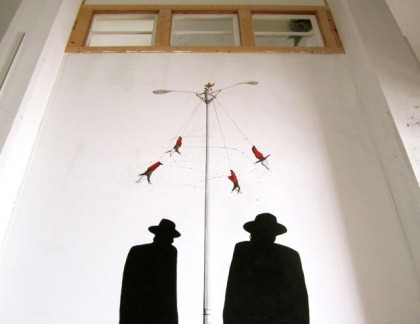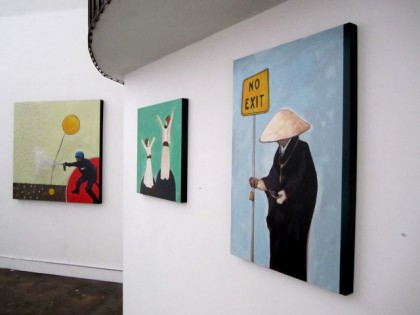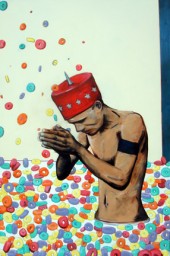In a commencement speech given to the graduates of Kenyon University in 2005, the late author David Foster Wallace points out that sometimes the most obvious realities are the ones that are hardest to see and talk about. He tells the story of two fish that, when asked, “How’s the water?” can only ask each other, “What the hell is water?”
I love that parable and am reminded of it when looking at Severn Eaton’s paintings now on display at Flood Gallery Fine Art Center in the River Arts District. Eaton juxtaposes imagery from around the world to draw attention to the places where belief systems overlap, clash or parallel each other. He shows us the proverbial water of this fishbowl known as planet earth.
Eaton lives in Asheville and studied fine art at Appalachian State University and UNC-Chapel Hill. He paints his thoughtful compositions with a steady hand and luscious applications of paint, tending toward a contemporary palette of bright colors, stylized shapes and austere backgrounds. In the painting “Mother & Child,” a shrouded woman holds a baby whose face is entirely concealed by a tribal mask. Another painting, “Juicy,” depicts a woman in traditional African headdress wearing sweatpants with the word “juicy” across the backside. In “Bath,” a holy man rejoices in a giant bowl of Fruit Loops.
It might seem disrespectful or sacrilegious to appropriate images in this way, but this consequence promotes Eaton’s decree that everything is relative. By leveling the playing field, all belief systems are heralded and called into question — from the uniformed riot policeman to a benevolent group of Amish men. “Who loses when I win?” Eaton asks in his artist statement. “Whose hell is worse? What is natural in the ritual, in the political?”
A subtext emerges from the way in which the paintings relate to each other. Actions and rituals are repeated within wholly different contexts. “Untitled” depicts two Sufis dancing with arms raised, behind them — a repetition of dots and lines that look biological, or even mystical. Across the gallery, “Rejoice” depicts a fellow with an orange life buoy, arms raised above his head; he stands beneath the light of the moon in a sea of lily pads.
Most remarkable is Eaton’s site-specific painting perched on the highest wall of Flood: a whirling street-lamp Maypole of bodies strung up by their feet. They are rendered so lightly that at first it’s hard to see the burlap bags covering their heads; a trail of dust spirals onto two ominous characters looming in the foreground.
I admit that I don’t know the significance of all the specific rituals and garb represented in Eaton’s paintings; my knowledge of such social customs runs about as deep as my collection of National Geographic magazines. Eaton’s paintings remind me that I may never fully comprehend exactly what these cultural references are — certainly not through the glossy pages of a magazine. On some deeper level, it all makes absolute sense. Culture Shock hangs at Flood Gallery until May 31.
Flood Gallery Fine Art Center 109 Roberts St. 254-2166 floodgallery.org






Before you comment
The comments section is here to provide a platform for civil dialogue on the issues we face together as a local community. Xpress is committed to offering this platform for all voices, but when the tone of the discussion gets nasty or strays off topic, we believe many people choose not to participate. Xpress editors are determined to moderate comments to ensure a constructive interchange is maintained. All comments judged not to be in keeping with the spirit of civil discourse will be removed and repeat violators will be banned. See here for our terms of service. Thank you for being part of this effort to promote respectful discussion.